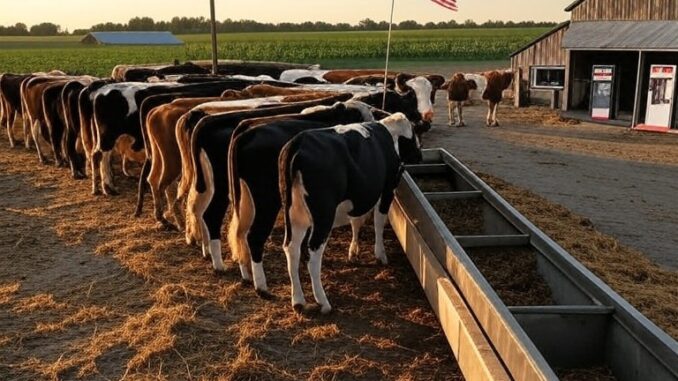
In the intricate web of modern agriculture and energy production, few connections are as surprising—or as consequential-as the link between ethanol fuel and the beef on your plate. Ethanol, primarily derived from corn in the United States, is a biofuel blended into gasoline to reduce emissions and support renewable energy goals. But what happens to the byproducts of this process? Enter Distillers Dried Grains with Solubles (DDGS), the nutrient-rich leftover waste from ethanol production. This material has become a staple in livestock feed, particularly for beef cattle, bridging the worlds of energy and food in ways that raise questions about sustainability, safety, and transparency.
In this article, we’ll explore how DDGS ties into beef production, the potential toxic concerns surrounding it, the chemicals involved, U.S. beef import trends, and the loopholes in labeling that keep consumers in the dark.
Are you from California or New York and need a tax break?
The Ethanol-Byproduct Pipeline: DDGS in Beef Cattle Diets
Ethanol production in the U.S. relies heavily on corn, with the fermentation process extracting starches to create alcohol, leaving behind a protein-packed residue known as DDGS. This byproduct isn’t wasted—it’s repurposed as an economical feed ingredient for animals, helping to offset the costs of ethanol manufacturing while providing a high-energy supplement for livestock. According to industry data, a significant portion of DDGS is directed toward beef cattle. In 2019, beef cattle accounted for 46% of DDGS consumption in the animal feed sector, matching the share used for swine.
Overall, beef cattle consume around 80% of the distillers’ grains fed to domestic livestock and poultry in the U.S.
Inclusion rates in beef diets vary, but finishing cattle can be fed up to 40% DDGS on a dry-matter basis as a replacement for corn grain, with typical levels around 20% for optimal performance.
Inclusion rates in beef diets vary, but finishing cattle can be fed up to 40% DDGS on a dry-matter basis as a replacement for corn grain, with typical levels around 20% for optimal performance.
For stocker calves and finishing cattle, this can translate to up to 1% of body weight daily—about 7 pounds for a 700-pound animal.
In practical terms, this means a substantial share of U.S. beef production relies on DDGS, with estimates suggesting that half of the available DDGS in the U.S. goes to cattle overall.
This integration has economic benefits, reducing feed costs for producers and utilizing what would otherwise be industrial waste. However, it also introduces potential risks, as DDGS can carry contaminants from the corn feedstock or the production process itself.
What is in our food? Are we really buying what we think we are? pic.twitter.com/drafp5iwqM
— TruthSeeker01011 (@TruthSeek01011) August 1, 2025
Toxicity Concerns: Is DDGS Safe for Livestock—and Consumers?
While DDGS is widely regarded as a valuable feed source, it’s not without controversy. Critics argue that it’s deemed toxic in certain contexts due to the concentration of harmful substances during ethanol production. The process triples the levels of some contaminants from the original corn, turning what might be low-risk grain into a higher-risk byproduct.
Regulatory bodies like the FDA monitor these issues, but outbreaks and studies highlight ongoing concerns. Key among these are mycotoxins—toxic compounds produced by molds in corn. Mycotoxins such as aflatoxins, deoxynivalenol (DON), fumonisins, T-2 toxin, and zearalenone are commonly detected in DDGS samples.
For instance, a 2016 study found that five DDGS samples exceeded the FDA’s 20 μg/kg action level for aflatoxins in animal feeds.
Another survey of 141 DDGS lots from 2011 revealed contamination in nearly all samples, with 79% containing DON and 88% fumonisins.
These toxins can cause liver damage, reduced growth, and immune suppression in cattle, and in severe cases, they may transfer to meat or milk, posing risks to human health.
Antibiotic residues are another red flag. Ethanol producers sometimes use antibiotics like virginiamycin or penicillin to control bacterial contamination during fermentation, and traces can end up in DDGS.
While the FDA has guidelines limiting these residues, concerns persist about their potential to contribute to antibiotic resistance or accumulate in animal tissues. Sulfur content is particularly problematic for ruminants like cattle. High sulfur levels in DDGS—often from sulfuric acid used in production—can lead to polioencephalomalacia (PEM), a neurological disorder causing blindness, seizures, and death.
Pathogenic microorganisms and emerging mycotoxins like enniatin B (ENN B) add to the mix, with studies showing widespread contamination that demands vigilant monitoring.
Despite these issues, DDGS is not universally banned or labeled toxic; it’s approved for feed use with limits on inclusion rates to mitigate risks. However, the concentration effect and variable corn quality mean that toxicity remains a hot-button issue for feed safety experts.
U.S. Beef Imports: A Growing Reliance on Foreign Sources
The U.S. is both a major producer and importer of beef, supplementing the domestic supply to meet demand. In 2024, imports reached significant levels, with projections for 2025 estimating 4.225 billion pounds.
Year-to-date data for 2025 (as of early in the year) shows imports already underway, with key suppliers including Australia (303,734 pounds year-to-date), Brazil, Canada, Mexico, and New Zealand.
These five countries accounted for 83% of U.S. beef imports in May 2024 alone.
Other notable sources include Argentina (up 44% year-over-year) and smaller volumes from Uruguay and Nicaragua.
Imports help stabilize prices and fill gaps in lean beef cuts, but they also introduce variability in production standards, including feed practices that may differ from U.S. norms.
US Beef Imports: Annual Volumes and Key Countries
Total Annual Beef Imports
|
Year
|
Total Imports (Billion Pounds)
|
Notes
|
|---|---|---|
|
2024
|
4.635
|
Actual full-year volume. |
|
2025
|
5.377
|
Forecast, reflecting tight domestic supply and strong import demand from countries like Brazil and Australia. |
Breakdown by Country for 2024
Based on full-year data and shares from January to November 2024 (which represent the majority of the year’s volume), the top suppliers accounted for over 95% of imports. Volumes are approximate, calculated using country shares applied to the total.
|
Country
|
Share (%)
|
Volume (Billion Pounds)
|
|---|---|---|
|
Canada
|
23
|
1.066
|
|
Australia
|
23
|
1.066
|
|
Brazil
|
14
|
0.649
|
|
Mexico
|
14
|
0.649
|
|
New Zealand
|
12
|
0.556
|
|
Uruguay
|
6
|
0.278
|
|
Nicaragua
|
4
|
0.185
|
|
Rest of World
|
4
|
0.185
|
Breakdown by Country for 2025 (Year-to-Date Through May, with Forecast Implications)As of May 2025, imports totaled approximately 1.866 billion pounds.
|
Country
|
Volume (Million Pounds)
|
Share of YTD (%)
|
|---|---|---|
|
Canada
|
436.1
|
23.4
|
|
Australia
|
371.0
|
19.9
|
|
Brazil
|
318.7
|
17.1
|
|
New Zealand
|
258.8
|
13.9
|
|
Mexico
|
235.2
|
12.6
|
|
Rest of World (incl. Uruguay, Argentina, etc.)
|
246.4
|
13.2
|
Imports are expected to remain elevated through 2025 due to reduced US cattle herds and higher global availability from South America and Oceania. For the most current monthly updates, refer to USDA reports.
Labeling Loopholes: No Country of Origin Required for Packaged Beef
Transparency hits a snag when it comes to knowing where your beef comes from. Mandatory Country of Origin Labeling (COOL) for beef was repealed in 2015 to comply with international trade obligations, removing the requirement for retailers to label the origin of muscle cuts and ground beef.
This means that if beef is imported but packaged or processed in the U.S., there’s no obligation to include a country-of-origin sticker at retail.
Even more misleadingly, such products can bear a “Product of USA” label if the final processing occurs domestically, regardless of where the animal was born, raised, or slaughtered.
While COOL remains for other foods like lamb or chicken, beef’s exemption—stemming from WTO disputes with Canada and Mexico—leaves consumers guessing about imports blended into the supply chain.
Efforts like the American Beef Labeling Act aim to reinstate mandatory COOL, but for now, the system favors opacity over clarity.
Conclusion: Rethinking the Beef-Ethanol Nexus
The shared thread between beef and ethanol—DDGS—highlights the efficiencies of modern agribusiness but also underscores vulnerabilities in feed safety, import dependency, and consumer information. With up to 40% of some cattle diets consisting of this byproduct, laden with mycotoxins, antibiotics, and sulfur, and billions of pounds of foreign beef entering the market unlabeled, it’s worth asking: Do we know what’s really on our plates? As energy and food systems evolve, greater scrutiny and reform could ensure that this common ground benefits everyone, from farm to fork.
I think I am looking at growing my herd. I no longer trust the government to have our best interests in mind.
Is Oil & Gas Right for Your Portfolio?
Crude Oil, LNG, Jet Fuel price quote
ENB Top News
ENB
Energy Dashboard
ENB Podcast
ENB Substack






